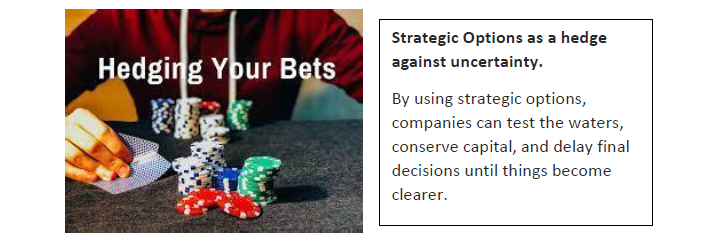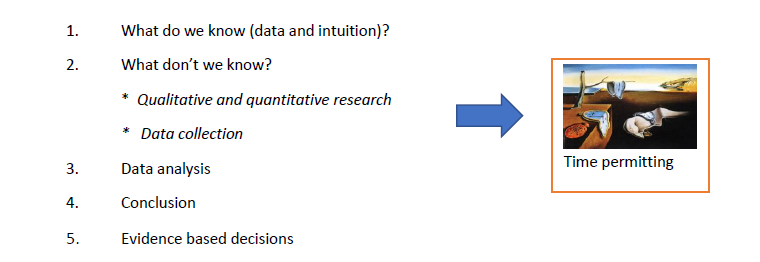The mythical magic of strategic planning
“Plans are nothing, planning is everything”. Dwight D. Eisenhower
Route to success:
- No magic bullet
- Ongoing, face-to-face debate with all your stakeholders about:
– emerging data
– unspoken assumptions
– difficult choices
Route to failure:
- Being half-hearted
- Being schizophrenic
CONTEXT
Strategy that we know from our textbooks and that is taught at MBA programs all over the world is the approach that is driven by missions and visions, relies heavily on external and internal analysis, is supported by numerous tools, and targets at formulating and implementing an inspiring strategy that will beat the competition over the next three years. Lightning never strikes the same place twice — it does. There is no gravity in space — there is, just less. Humans only use 10% of their brains — actually, a lot more — yes, even men. Pigeons blow up if fed uncooked rice — they don’t.
DEBUNKING THE MYTHS
Good strategy is not the product of endless research and modeling; it’s the result of a simple process of thinking through how to hit a target and whether it’s realistic to try. Fear and discomfort are part of the process because decisions have to be made about a future you can only guess at. Such decisions also deliberately exclude possibilities and options. Generally speaking, most managers try mitigating their fear by using tried and tested models and spending endless hours developing a plan, however, planning is not strategy.
Formulating a strategy freezes it. Once a strategy is formulated, it remains a static plan—unless it is reformulated. It also means there are ‘opportunity costs’ as economists call them – alternative opportunities and/or new directions are given up in place of the formulated strategy. Everything is not an “either or,” you need to allow for “and.”
A formulated strategy itself doesn’t get your organisation anywhere. It is insights, decisions, and actions that drive organisations and that bring them to the next level.
Costs lend themselves wonderfully to planning because the company controls them. But for revenue, customers are in charge. Planning can’t make revenue magically appear so focus on the key choices that influence the revenue decision makers, the customers.
Strategy is an ‘emergent’ process or a ‘dynamic steering’ process as you respond to changes in your environment. It is about what we are going to do now to help shape the future to our advantage. It is therefore not about the long term or the short term, it is about the fundamentals of the business.
To be successful, particularly in this volatile, uncertain, complex and ambiguous world, organisations need a strong and adaptive strategy process that makes sure an organisation is doing the right things continuously. And this process involves far more than just formulating a strategy. Its primary focus needs to be on execution.
Being agile is not a strategy, it is a capability, and a very valuable one which has immediate operational benefits; however, it is very unlikely to positively affect a firm’s competitive position. Right decisions are needed to direct that capability.
A strategy is not a plan, it is a framework for decision-making, a set of guiding principles which can be applied as the situation evolves.
A company is complex system and if you try to optimise the parts you run the risk of sub-optimising the whole. You don’t want strategies for the individual departments, for example, IT, finance, HR or anything else – just a strategy for the business and that is when the ‘whole becomes greater than the sum of its various parts’.
Rule 1: Keep the strategy simple
Two choices determine success: the where-to-play decision (which specific customers to target) and the how-to-win decision (how to create a compelling value proposition for those customers).
Rule 2: Recognise that strategy is not about perfection
- As strategy is primarily about revenue rather than cost, perfection is an impossible standard.
- At its very best, therefore, strategy just shortens the odds of a company’s bets.

Rule 3: Make the logic explicit
- The only sure way to improve the hit rate of your strategic choices is to test the logic of your thinking.
- For your choices to make sense, what do you need to believe (and then verify) about customers, about your industry, about competition, about your capabilities?
- It is strategy that compels customers to give the company its revenue.
- Planning, cost control, and capabilities determine whether the revenue can be obtained at a price that is profitable for the company.
Strategy is about making bets and articulating the logic behind strategic choices.
Therefore, a decision-making model is required based on one or all of the following:
- Gut feel (unspoken assumptions)
- Intuition (biases)
or - Data (objective)
When a decision needs to be made, rather than solely relying on one’s intuition (experience-based insights), success of the ‘right’ decision is improved if supplemented with meaningful data, but remember what Albert Einstein once said:
“We cannot solve our problems with the same thinking we used when we created them”.
Management is not a science versus an art but a combination of both.


A final thought, Peter Drucker (the well-known management consultant, educator and author) once said “Culture eats strategy for breakfast”. He didn’t mean that strategy is unimportant – rather, that a powerful and empowering culture increases the chances of organisational success. A big shift in organisational development research has been to find ways of creating cultures that are flexible and innovative and where individuals are empowered to make decisions and therefore take responsibility for results. The outcome is a productive workforce that is generally happy and ‘values’ driven, but also underpinned by good strategy.
Formal authority has its limits for good leadership. Enduring leadership requires honesty, trust, integrity and transparency; to say ‘I don’t know’ when you don’t (but endeavour to find out) and to admit mistakes, but to learn from them. These are the pillars that will influence initiative, good decision making and engender positive and productive culture.
Having been a CEO myself, the questions I sought answers for every day were:
- How do we create value for our customers?
- Is it unique? If so
- What is our pricing model?
- Can we scale? If so
- Have we the resources?
- Are our customers’ needs changing?
- Is the industry shifting?
- Can we re-deploy our core competencies into new products and/or new markets?
- Do we have shared values?
- Do we have a shared language and consistent narrative?
- Are the touch points along our value chain consistent?
- Do we care for each other?
- Do we care for our customers?
And to return to Eisenhower, the conclusion that follows from all of the above can be summarised as follows:
“Strategies are nothing; strategising is everything.“
Damian Scanlon has had more than 15 years senior executive experience, working for major Australian publicly listed companies, mainly in the aviation and mineral processing industries, with short stints in the banking and oil industries early in his career. Positions he has held include senior executive management, including CEO, and board positions in subsidiary companies, requiring extensive travel throughout Australia, Europe, North America and Asia. His roles have seen him based in Canberra, Sydney, Melbourne and Adelaide.
References: S Bungay, “5 Myths About Strategy”, HBR April 2019
J Kraaijenbrink, “The 10 Myths of Strategy”, Forbes, March 2019
R Martin, “The Big Lie of Strategic Planning”, HBR Jan-Feb 2014




